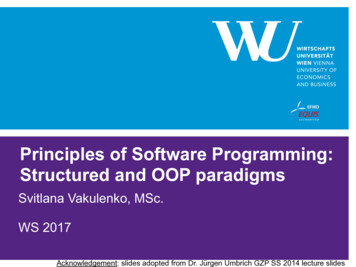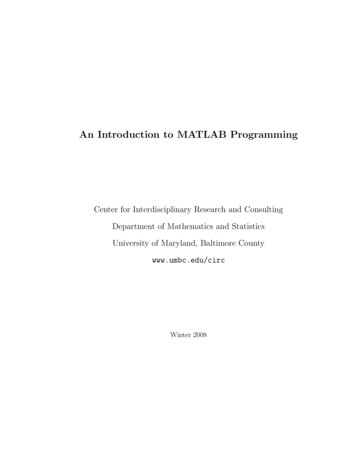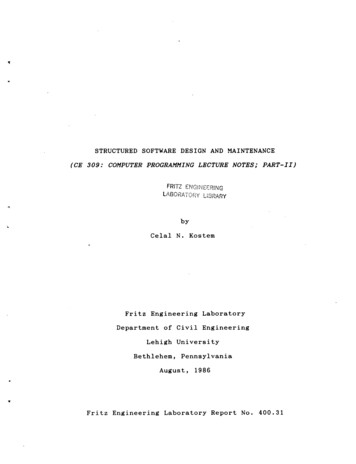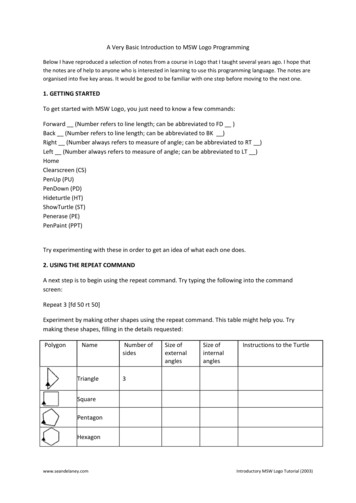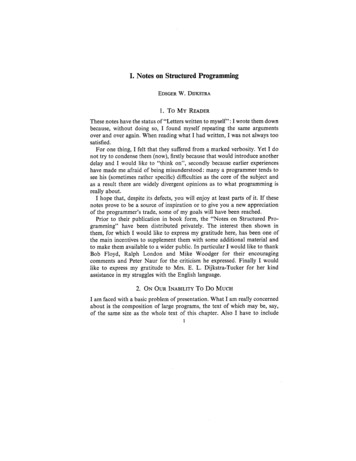
Transcription
I. Notes on Structured ProgrammingEDSGER W. DIJKSTRA1. T o MY READERThese notes have the status of "Letters written to myself": I wrote them downbecause, without doing so, I found myself repeating the same argumentsover and over again. When reading what I had written, I was not always toosatisfied.For one thing, I felt that they suffered from a marked verbosity. Yet I donot try to condense them (now), firstly because that would introduce anotherdelay and I would like to "think on", secondly because earlier experienceshave made me afraid of being misunderstood: many a programmer tends tosee his (sometimes rather specific) difficulties as the core of the subject andas a result there are widely divergent opinions as to what programming isreally about.I hope that, despite its defects, you will enjoy at least parts of it. If thesenotes prove to be a source of inspiration or to give you a new appreciationof the programmer's trade, some of my goals will have been reached.Prior to their publication in book form, the "Notes on Structured Programming" have been distributed privately. The interest then shown inthem, for which I would like to express my gratitude here, has been one ofthe main incentives to supplement them with some additional material andto make them available to a wider public. In particular I would like to thankBob Floyd, Ralph London and Mike Woodger for their encouragingcomments and Peter Naur for the criticism he expressed. Finally I wouldlike to express my gratitude to Mrs. E. L. Dijkstra-Tucker for her kindassistance in my struggles with the English language.2. ON OUR INABILITY TO D o MUCHI am faced with a basic problem of presentation. What I am really concernedabout is the composition of large programs, the text of which may be, say,of the same size as the whole text of this chapter. Also I have to include1
E. W. DIJKSTRAexamples to illustrate the various techniques. For practical reasons, thedemonstration programs must be small, many times smaller than the "lifesize programs" I have in mind. My basic problem is that precisely thisdifference in scale is one of the major sources of our difficulties in programmingtIt would be very nice if I could illustrate the various techniques withsmall demonstration programs and could conclude with " . . . and when facedwith a program a thousand times as large, you compose it in the same way."This common educational device, however, would be self-defeating as one ofmy central themes will be that any two things that differ in some respect by afactor of already a hundred or more, are utterly incomparable.History has shown that this truth is very hard to believe. Apparently we aretoo much trained to disregard differences in scale, to treat them as "gradualdifferences that are not essential". We tell ourselves that what we can do once,we can also do twice and by induction we fooI ourselves into believing that wecan do it as many times as needed, but this is just not truer A factor of athousand is already far beyond our powers of imagination tLet me give you two examples to rub this in. A one-year old child willcrawl on all fours with a speed of, say, one mile per hour. But a speed of athousand miles per hour is that of a supersonic jet. Considered as objectswith moving ability the child and the jet are incomparable, for whatever onecan do the other cannot and vice versa. Also: one can close one's eyes andimagine how it feels to be standing in an open place, a prairie or a sea shore,while far away a big, reinless horse is approaching at a gallop, one can "see"it approaching and passing. To do the same with a phalanx of a thousand ofthese big beasts is mentally impossible" your heart would miss a number ofbeats by pure panic, if you could!To complicate matters still further, problems of size do not only cause meproblems of presentation, but they lie at the heart of the subject: widespreadunderestimation of the specific difficulties of size seems one of the majorunderlying causes of the current software failure. To all this I can see onlyone answer, viz. to treat problems of size as explicitly as possible. Hence thetitle of this section.To start with, we have the "size" of the computation, i.e. the amount ofinformation and the number of operations involved in it. It is essential thatthis size is large, for if it were really small, it would be easier not to use thecomputer at all and to do it by hand. The automatic computer owes its rightto exist, its usefulness, precisely to its ability to perform large computationswhere we humans cannot. We want the computer to do what we could neverdo ourselves and the power of present-day machinery is such that even smallcomputations are by their very size already far beyond the powers of ourunaided imagination.
NOTES ON STRUCTURED PROGRAMMING3Yet we must organise the computations in such a way that our limitedpowers are sufficient to guarantee that the computation will establish thedesired effect. This organising includes the composition of the program andhere we are faced with the next problem of size, viz. the length of the programtext, and we should give this problem also explicit recognition. We shouldremain aware of the fact that the extent to which we can read or write a textis very much dependent on its size. In my country the entries in the telephonedirectory are grouped by town or village and within each such group thesubscribers are listed by name in alphabetical order. I myself live in a smallvillage and given a telephone number I have only to scan a few columns tofind out to whom the telephone number belongs, but to do the same in a largecity would be a major data processing task!It is in the same mood that I should like to draw the reader's attention tothe fact that "clarity" has pronounced quantitative aspects, a fact manymathematicians, curiously enough, seem to be unaware of. A theorem statingthe validity of a conclusion when ten pages full of conditions are satisfied ishardly a convenient tool, as all conditions have to be verified whenever thetheorem is appealed to. In Euclidean geometry, Pythagoras' Theorem holdsfor any three points A, B and C such that through A and C a straight linecan be drawn orthogonal to a straight line through B and C. How manymathematicians appreciate that the theorem remains applicable when some orall of the points A, B and C coincide? Yet this seems largely responsible forthe convenience with which Pythagoras' Theorem can be used.Summarizing: as a slow-witted human being I have a very small head and Ihad better learn to live with it and to respect my limitations and give them fullcredit, rather than to try to ignore them, for the latter vain effort will bepunished by failure.3. ON THE RELIABILITY OF MECHANISMSBeing a programmer by trade, programs are what I am talking about and thetrue subject of this section really is the reliability of programs. That, nevertheless, I have mentioned "mechanisms" in its title is because I regardprograms as specific instances of mechanisms, and that I wanted to express,at least once, my strong feeling that many of my considerations concerningsoftware are, mutatis mutandis, just as relevant for hardware design.Present-day computers are amazing pieces of equipment, but most amazingof all are the uncertain grounds on account of which we attach any validity totheir output. It starts already with our belief that the hardware functionsproperly.Let us restrict, for a moment, our attention to the hardware and let uswonder to what extent one can convince oneself of its being properly con-
4E . W . DIJKSTRAstructed. Some years ago a machine was installed on the premises of myUniversity; in its documentation it was stated that it contained, among manyother things, circuitry for the fixed-point multiplication of two 27-bit integers.A legitimate question seems to be" "Is this multiplier correct, is it performingaccording to the specifications?".The naive answer to this is: "Well, the number of different multiplicationsthis multiplier is claimed to perform correctly is finite, viz. 25., so let ustry them all." But, reasonable as this answer may seem, it is not, for althougha single multiplication took only some tens of microseconds, the total timeneeded for this finite set of multiplications would add up to more than 10,000years! We must conclude that exhaustive testing, even of a single componentsuch as a multiplier, is entirely out of the question. (Testing a completecomputer on the same basis would imply the established correct processingof all possible programs !)A first consequence of the 10,000 years is that during its life-time themultiplier will be asked to perform only a negligible fraction of the vastnumber of all possible multiplications it could do: practically none of them!Funnily enough, we still require that it should do any multiplication correctlywhen ordered to do so. The reason underlying this fantastic quality requirement is that we do not know in advance, which are the negligibly fewmultiplications it will be asked to perform. In our reasoning about ourprograms we talk about "the product" and have abstracted from the specificvalues of the factors: we do not know them, we do not wish to know them,it is not our business to know them, it is our business not to know them!Our wish to think in terms of the concept "the product", abstracted from thespecific instances occurring in a computation is granted, but the price paidfor this is precisely the reliability requirement that any multiplication of thevast set will be performed correctly. So much for the justification of ourdesire for a correct multiplier.But how is the correctness established in a convincing manner? As long asthe multiplier is considered as a black box, the only thing we can do is "testingby sampling", i.e. offering to the multiplier a feasible amount of factor pairsand checking the result. But in view of the 10,000 years, it is clear that we canonly test a negligible fraction of the possible multiplications. Whole classesof in some sense "critical" multiplications may remain untested and in viewof the reliabillty justly desired, our quality control is still most unsatisfactory.Therefore it is not done that way.The straightforward conclusion is the following: a convincing demonstration of correctness being impossible as long as the mechanism is regardedas a black box, our only hope lies in not regarding the mechanism as a blackbox. I shall call this "taking the structure of the mechanism into account".
NOTES ON STRUCTURED PROGRAMMING5From now onwards the type of mechanisms we are going to deal with areprograms. (In many respects, programs are mechanisms much easier to dealwith than circuitry, which is really an analogue device and subject to wear andtear.) And also with programs it is fairly hopeless to establish the correctnessbeyond even the mildest doubt by testing, without taking their structure intoaccount. In other words, we remark that the extent to which the programcorrectness can be established is not purely a function of the program'sexternal specifications and behaviour but depends critically upon its internalstructure.Recalling that our true concern is with really large programs, we observe asan aside that the size itself requires a high confidence level for the individualprogram components. If the chance of correctness of an individual componentequals p, the chance of correctness of a whole program, composed of N suchcomponents, is something likep pN.As N will be very large, p should be very, very close to 1 if we desire P todiffer significantly from zero!When we now take the position that it is not only the programmer's task toproduce a correct program but also to demonstrate its correctness in a convincing manner, then the above remarks have a profound influence on theprogrammer's activity: the object he has to produce must be usefullystructured.The remaining part of this monograph will mainly be an exploration ofwhat program structure can be used to good advantage. In what follows itwill become apparent that program correctness is not my only concern,program adaptability or manageability will be another. This stress on programmanageability is my deliberate choice, a choice that, therefore, I should liketo justify.While in the past the growth in power of the generally available equipmenthas mitigatedthe urgency of the efficiency requirements, this very same growthhas created its new difficulties. Once one has a powerful machine at one'sdisposal one tries to use it and the size of the problems one tackles adjustsitself to the scope of the equipment: no one thinks about programming analgorithm that would take twenty years to execute. With processing powerincreased by a factor of a thousand over the last ten to fifteen years, Man hasbecome considerably more ambitious in selecting problems that now shouldbe "technically feasible". Size, complexity and sophistication of programsone should like to make have exploded and over the past years it has becomepatently clear that on the whole our programming ability has not kept pacewith these exploding demands made on it.
6E. W.DIJKSTRAThe power of available equipment will continue to grow" we can expectmanufacturers to develop still faster machines and even without that development we shall witness that the type of machine that is presently considered asexceptionally fast will become more and more common. The things we shouldlike to do with these machines will grow in proportion and it is on thisextrapolation that I have formed my picture of the programmer's task.My conclusion is that it is becoming most urgent to stop to considerprogramming primarily as the minimization of a cost/performance ratio. Weshould recognise that already now programming is much more an intellectualchallenge: the art of programming is the art of organising complexity, ofmastering multitude and avoiding its bastard chaos as effectively as possible.My refusal to regard efficiency considerations as the programmer's primeconcern is not meant to imply that I disregard them. On the contrary,efficiency considerations are recognised as one of the main incentives tomodifying a logically correct program. My point, however, is that we canonly afford to optimise (whatever that may be) provided that the programremains sufficiently manageable.Let me end this section with a final aside on the significance of computers.Computers are extremely flexible and powerful tools and many feel that theirapplication is changing the face of the earth. I would venture the opinion thatas long as we regard them primarily as tools, we might grossly underestimatetheir significance. Their influence as tools might turn out to be but a rippleon the surface of our culture, whereas I expect them to have a much moreprofound influence in their capacity of intellectual challenge!Corollary of the first part of this section:Program testing can be used to show the presence of bugs, but never toshow their absence!4. ON OUR MENTAL AIDSIn the previous section we have stated that the programmer's duty is to makehis product "usefully structured" and we mentioned the program structure inconnection with a convincing demonstration of the correctness of theprogram.But how do we convince? And how do we convince ourselves? What arethe typical patterns of thought enabling ourselves to understand? It is to abroad survey of such questions that the current section is devoted. It is writtenwith my sincerest apologies to the professional psychologist, because it willbe amateurishly superficial. Yet I hope (and trust) that it will be sufficient togive us a yardstick by which to measure the usefulness of a proposedstructuring.
NOTES ON STRUCTURED PROGRAMMING7Among the mental aids available to understand a program (or a proof of itscorrectness) there are three that I should like to mention explicitly:(1) Enumeration(2) Mathematical induction(3) Abstraction.4.1. ON ENUMERATIONI regard as an appeal to enumeration the effort to verify a property of thecomputations that can be evoked by an enumerated set of statements performed in sequence, including conditional clauses distinguishing between twoor more cases. Let me give a simple example of what I call "enumerativereasoning".It is asked to establish that the successive execution of the following twostatements"dd: dd/2;ifdd r dor : r -dd"operating on the variables " r " and "dd" leaves the relations0 r dd(1)invariant. One just "follows" the little piece of program assuming that (1) issatisfied to start with. After the execution of the first statement, which halvesthe value of dd, but leaves r unchanged, the relations0 r 2*dd(2)will hold. Now we distinguish two mutually exclusive cases.(1) dd r. Together with (2) this leads to the relationsdd r 2*dd;(3)In this case the statement following do wilt be executed, ordering a decreaseof r by dd, so that from (3) it follows that eventuallyO r d d ,i.e. (1) will be satisfied.(2) non dd r (i.e. d d r). In this case the statement following do will beskipped and therefore also r has its final value. In this case " d d r " togetherwith (2), which is valid after the execution of the first statement leadsimmediately toO r ddso that also in the second case (1) will be satisfied.Thus we have completed our proof of the invariance of relations (1), wehave also completed our example of enumerative reasoning, conditionalclauses included.
8E. W. DIJKSTRA4.2. ON MATHEMATICALINDUCTIONI have mentioned mathematical induction explicitly because it is the onlypattern of reasoning that I am aware of that eventually enables us to copewith loops (such as can be expressed by repetition clauses) and recursiveprocedures. I should like to give an example.Let us consider the sequence of valuesdo, dl, d2,d3,.(1)given byfori 0for i 0di D(2a)d f(d 1)(2b)where D is a given value and f a given (computable) function. It is asked tomake the value of the variable "d" equal to the first value dk in the sequencethat satisfies a given (computable) condition "prop '. It is given that such avalue exists for finite k. A more formal definition of the requirement is toestablish the relationd dk(3)where k is given by the (truth of the) expressionsprop (dk)andnon prop (d3 for all i satisfying 0 i k(4)(5).We now consider the following program part:"d: D;while non prop (d) do d: f ( d ) "(6)in which the first line represents the initialisation and the second one the loop,controlled by the (hopefully self-explanatory) repetition clause while.do.(In terms of the conditional clause i f . . . do, used in our previous example, amore formal definition of the semantics of the repetition clause is by statingthat"while B do S"is semantically equivalent with"if B dobegin S; while B do S end"expressing that "non B" is the necessary and sufficient condition for therepetition to terminate.)Calling in the construction "while B do S" the statement S "the repeatedstatement" we shall prove that in program (6):after the nth execution of the repeated statement will hold (for n 0)d d (7a)
NOTES ON STRUCTURED PROGRAMMINGandnonprop (di) for all i satisfying 0 i n.9(7b)The above statement holds for n 0 (by enumerative reasoning); we haveto prove (by enumerative reasoning) that when it holds for n N ( N 0),it will also hold for n N 1.After the Nth execution of the repeated statement relations (7a) and (7b)are satisfied for n N. For the N 1st execution to take place, the necessaryand sufficient condition is the truth ofnonprop (d)which, thanks to (7a) for n N (i.e. d dN) meansnonprop (dN)leading to condition (7b) being satisfied for n N 1. Furthermore,d dN and (2b) leads tof ( d ) dN 1so that the net effect of the N 1st execution of the repeated statement"d: f ( d ) "established the relationd dN li.e. relation (7a) for N N 1 and thus the induction step (7) has beenproved.Now we shall show that the repetition terminates after the kth executionof the repeated statement. The nth execution cannot take place for n kfor (on account of 7b) this would implynonprop (dk)thereby violating (4). When the repetition terminates after the nth executionof the repeated statement, the necessary and sufficient condition for termination, viz.non (non prop (d))becomes, thanks to (7a)prop (dn).(8)This excludes termination for n k, as this would violate (5). As a result therepetition will terminate with n k, so that (3) follows from (7a), (4) followsfrom (8) and (5) follows from (Tb). Which terminates our proof.Before turning our attention away from this example illustrating the use ofmathematical induction as a pattern of reasoning, I should like to add someremarks, because I have the uneasy feeling that by now some of my readers(in particular experienced and competent programmers) will be terriblyirritated, viz. those readers for whom program (6) is so obviously correctthat they wonder what all the fuss is about: " W h y his pompous restatement
10E. W. DIJKSTRAof the problem, as in (3), (4) and (5), because anyone knows what is meantby the first value in the sequence, satisfying a condition? Certainly he doesnot expect us, who have work to do, to supply such lengthy proofs, with allthe mathematical dressing, whenever we use such a simple loop as that?"Etc.To tell the honest truth: the pomp and length of the above proof infuriateme as well! But at present I cannot do much better if I really try to prove thecorrectness of this program. But it sometimes fills me with the same kind ofanger as years ago the crazy proofs of the first simple theorems in planegeometry did, proving things of the same degree of "obviousness" as Euclid'saxioms themselves.Of course I would not dare to suggest (at least at present!) that it is theprogrammer's duty to supply such a proof whenever he writes a simple loopin his program. If so, he could never write a program of any size at all! Itwould be as impractical as reducing each proof in plane geometry explicitlyand in extenso to Euclid's axioms. (Cf. Section "On our inability to domuch.")My moral is threefold. Firstly, when a programmer considers a construction like (6) as obviously correct, he can do so because he is familiar with theconstruction. I prefer to regard his behaviour as an unconscious appeal to atheorem he knows, although perhaps he has never bothered to formulate it;and once in his life he has convinced himself of its truth, although he hasprobably forgotten in which way he did it and although the way was(probably) unfit for print. But we could call our assertions about program(6), say, "The Linear Search Theorem" and knowing such a name it is mucheasier (and more natural) to appeal to it consciously.Secondly, to the best of my knowledge, there is no set of theorems of thetype illustrated above, whose usefulness has been generally accepted. But weshould not be amazed about that, for the absence of such a set of theorems is adirect consequence of the fact that the type of object i.e, p r o g r a m s h a s notsettled down. The kind of object the programmer is dealing with, viz.programs, is much less well-established than the kind of object that is dealtwith in plane geometry. In the meantime the intuitively competent programmeris probably the one who confines himself, whenever acceptable, to programstructures with which he is very familiar, while becoming very alert andcareful whenever he constructs something unusual (for him). For an established style of programming, however, it might be a useful activity to lookfor a body of theorems pertinent to such programs.Thirdly, the length of the proof we needed in our last example is a warningthat should not be ignored. There is of course the possibility that a bettermathematician will do a much shorter and more elegant job than I have done.Personally I am inclined to conclude from this length that programming is
NOTES ON STRUCTURED PROGRAMMING11more difficult than is commonly assumed: let us be honestly humble andinterpret the length of the proof as an urgent advice to restrict ourselves tosimple structures whenever possible and to avoid in all intellectual modesty"clever constructions" like the plague.4.3. ON ABSTRACTIONAt this stage I find it hard to be very explicit about the role of abstraction,partly because it permeates the whole subject. Consider an algorithm and allpossible computations it can evoke: starting from the computations thealgorithm is what remains when one abstracts from the specific valuesmanipulated this time. The concept of "a variable" represents an abstractionfrom its current value. It has been remarked to me (to my great regret. Icannot remember by whom and so I am unable to give credit where it seemsdue) that once a person has understood the way in which variables are used inprogramming, he has understood the quintessence of programming. We canfind a confirmation for this remark when we return to our use of mathematicalinduction with regard to the repetition: on the one hand it is by abstractionthat the concepts are introduced in terms of which the induction step can beformulated; on the other hand it is the repetition that really calls for theconcept of "a variable". (Without repetition one can restrict oneself to"quantities" the value of which has to be defined as most once but never hasto be redefined as in the case of a variable.)There is also an abstraction involved in naming an operation and using iton account of "what it does" while completely disregarding "how it works".(In the same way one should state that a programming manual describes anabstract machine" the specific piece of hardware delivered by the manufacturer is nothing but a--usually imperfect !--mechanical model of thisabstract machine.) There is a strong analogy between using a named operationin a program regardless of "how it works" and using a theorem regardlessof how it has been proved. Even if its proof is highly intricate, it may be avery convenient theorem to use!Here, again, I refer to our inability to do much. Enumerative reasoning isall right as far as it goes, but as we are rather slow-witted it does not go veryfar. Enumerative reasoning is only an adequate mental tool under the severeboundary condition that we use it only very moderately. We should appreciateabstraction as our main mental technique to reduce the demands made uponenumerative reasoning.(Here Mike Woodger, National Physical Laboratory, Teddington, England,made the following remark, which I insert in gratitude: "There is a parallelanalogy between the unanalysed terms in which an axiom or theorem isexpressed and the unanalysed operands upon which a named operation isexpected to act.")
12E. W . DIJKSTRA5. AN EXAMPLE OF A CORRECTNESS PROOFLet us consider the following program section, where the integer constantsa and d satisfy the relationsa 0 a n d d 0."integer r, dd;r' a; dd: d;while dd r do d d : 2 * d d ;while dd - d dobegin dd: dd/2;i f d d r d o r : r - ddend".To apply the Linear Search Theorem (see Section "On our mental aids",subsection "On mathematical induction") we consider the sequence of valuesgiven byfori 0dd dfor i 0ddi 2*ddi 1from whichddn d*2"(1)can be derived by normal mathematical techniques, which also tell us that(because d 0) for finite rddk rwill hold for some finite k, thus ensuring that the first repetition terminateswithdd d*2 kSolving the relationd 2 * d i - 1for d 1 givesd i - 1 dd2and the Linear Search Theorem then tells us, that the second repetition willalso terminate. (As a matter of fact the second repeated statement will beexecuted exactly the same number of times as the first one.)At the termination of the first repetition,dd ddkand therefore,0 r d d(2)holds. As shown earlier (Section "On our mental aids.", subsection "Onenumeration") the repeated statement of the second clause leaves this relation
NOTES ON STRUCTURED PROGRAMMING13invariant. After termination (on account of "while d d - d do") we canconcludedd dwhich together with (2) gives0 r d(3)Furthermore we prove that after the initialisationd d 0 mod (d)(4)holds; this follows, for instance, from the fact that the possible values of d dare (see (1))d*2 i for O i . k .Our next step is to verify, that after the initial assignment to r the relationa r mod (d)(5)holds.(1) It holds after the initial assignments.(2) The repeated statement of the first clause ("dd: 2*rid") maintainsthe invariance of (5) and therefore the whole first repetition maintains thevalidity of (5).(3) The second repeated statement consists of two statements. The first("rid: dd/2") leaves (5) invariant, the second one also leaves (5) invariant foreither it leaves r untouched or it decreases r by the current value of dd, anoperation which on account of (4) also maintains the validity of (5). Thereforethe whole second repeated statement leaves (5) invariant and therefore thewhole repetition leaves (5) invariant. Combining (3) and (5), the final valuetherefore satisfies0 r d a n d a r m o d ( d )i.e. r is the smallest non-negative remainder of the division of a by d.R e m a r k 1. The program"integerr, dd, q;r: a; dd: d; q: 0;while dd r do dd: 2 * dd;while d d # d dobegin dd: dd/2; q: 2 * q;i f d d r d o b e g i n r : r - dd; q : q l e n dendassigns to q the value of the corresponding quotient. The proof can beestablished by observing the invariance of the relationa q*dd r.(I owe this example to my colleague N. G. de Bruijn.)
14E. W .DIJKSTRARemark 2. In the subsection "On mathematical induction." we have provedthe Linear Search Theorem. In the previous proof we have used anothertheorem about repetitions (a theorem that, obviously, can only be proved bymathematical induction, but the proof is so simple that we leave it as anexercise to the reader),
I. Notes on Structured Programming EDSGER W. DIJKSTRA 1. To MY READER These notes have the status of "Letters written to myself": I wrote them down because, without doing so, I found myself repeating the same arguments over and over again. When re
